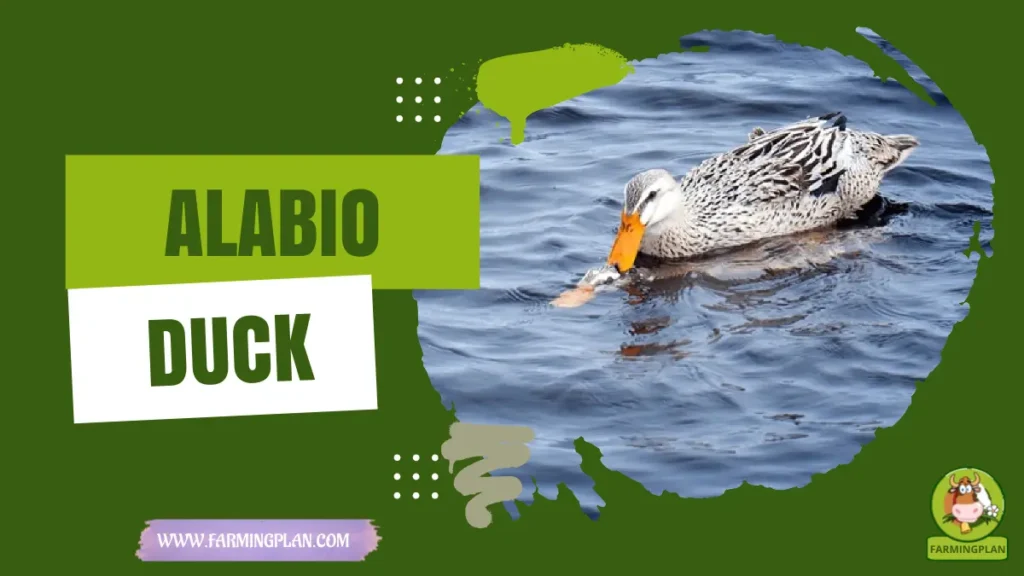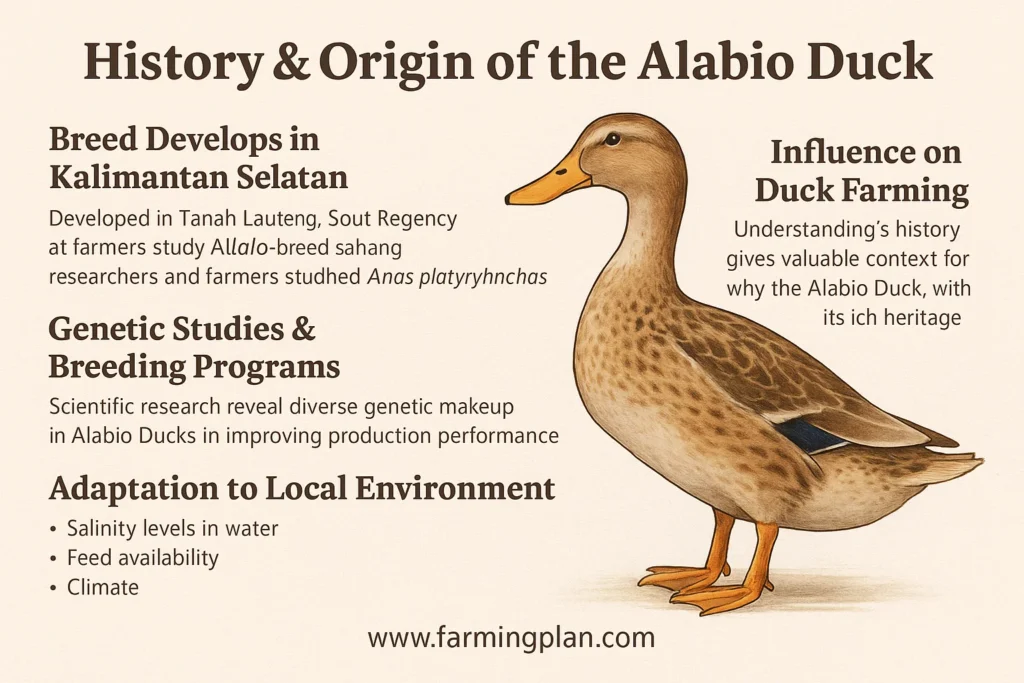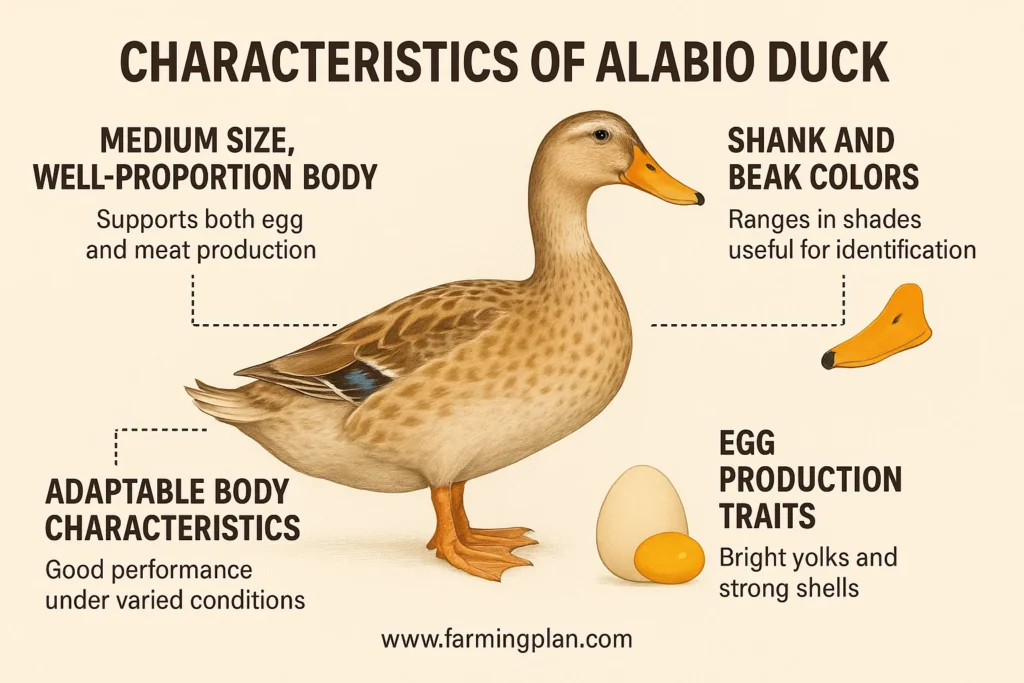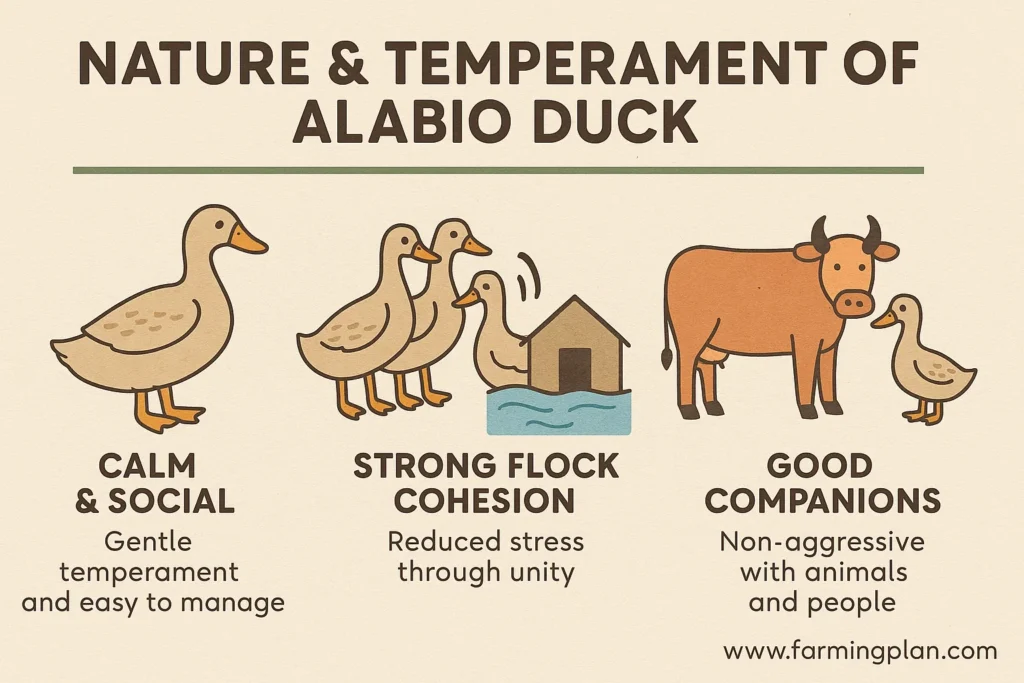Being a longtime farming expert, I am thrilled to look into the world of the Alabio Duck from South Kalimantan. Itik alabio is respected by farmers and breeders throughout Indonesia and Asia for producing excellent eggs and meat. It thrives in Borneo’s climate and produces good eggs with strong, clear yolks and tough shells. Gaining knowledge of how to care for the Alabio Duck can improve your farming results, no matter if you keep pets, have a smallholding or are a farmer. You’ll learn about how lizards developed, what they look like, how they feed and many more interesting points in a plain and simple format.

History & Origin of the Alabio Duck
From generations of living in its rich aquatic surroundings, the Tanah Laut Regency of South Kalimantan developed the Alabio Duck. Therefore, Asian Waterfowl Ducks are tough and well suited to warmth which earns them a place in the fields of farmers with similar weather. Local farmers and researchers at Lambung Mangkurat University have done a lot of research on the Alabio Duck and the important part it plays in the area’s duck populations. While closely related to the wild species Anas platyrhynchos, it shares some traits with the Khaki Campbell breed, but its unique features allow it to suit our local climate well.

Scientific studies, including those using microsatellite markers, reveal a diverse genetic makeup in Alabio Ducks, indicating a strong potential for breeding programs focused on improving production performance. These efforts align with ethical standards and government-supported animal husbandry initiatives. Understanding this history gives valuable context for why the Alabio Duck, with its rich heritage and significant role in Indonesian duck farming, remains a staple in the industry.
The breed’s origin in Kalimantan Selatan not only shapes its physical and behavioral traits but also influences farming practices. Over time, farmers have adapted to the unique environment—salinity levels in water, feed availability, and climate—all of which impact the duck’s health and production. This background forms the foundation for successful Alabio Duck care and farming.
Read More: Cayuga Duck: An American Duck
Characteristics of Alabio Duck
One of the standout features of the Alabio Duck is its well-proportioned body, characterized by medium size and balanced weight, which supports both egg and meat production. Its body length and height vary but generally suit farmers looking for a dual-purpose breed. The shank and beak colors often range in shades that help farmers quickly identify healthy individuals. Bright yellow egg yolks and strong, thick eggshells are trademarks of the breed, favored by consumers who care about egg quality. Studies measuring egg shell thickness and albumen quality consistently rate Alabio Duck eggs highly.

This breed shows good production performance even under varied environmental conditions, thanks to its adaptable body characteristics and efficient feed metabolism. Quantitative traits such as body weight and length can predict production levels, making it easier for farmers to select ducks with the best potential. The egg production traits—like average egg weight and internal quality factors—reflect well on the breed’s overall health and farming value. These characteristics not only make the Alabio Duck a local favorite but also a competitive breed in the larger context of Indonesian and Asian duck farming, a fact that farmers can take pride in.
Read More: Call Duck: Fall in Love With the Friendly
Nature & Temperament
In my experience, Alabio Ducks are calm and social birds, which makes them easy to manage for both beginners and experienced farmers. They show a gentle temperament and strong flock cohesion, traits that reduce stress and improve production. This breed adapts well to the tropical conditions of Kalimantan Selatan but thrives best when environmental factors such as clean water and proper shelter are maintained. Their behavior aligns well with local farming systems where ducks often share spaces with other animals.

My observations show that the temperament of Alabio Ducks fits the needs of people who sell a small number of ducks and people who breed them for fun. Because they don’t behave aggressively, they get along well with animals and people and help maintain good animal welfare practices. Routinely keeping track of their health statistics allows the ducks to live healthier and produce more. If ducks are content, their production improves and the Alabio breed’s unique personality is part of why it does well.
Read More: Aylesbury Duck: Raise England’s Finest White Duck
Food & Diet for Alabio Ducks
Feeding Alabio Ducks the right diet is crucial for maximizing their egg and meat production. I recommend a balanced feed rich in protein and essential nutrients, tailored to the duck’s life stage and production goals. Ducks require high-quality feed ingredients that support their metabolism and maintain healthy body weight. Daily feed intake should be carefully monitored to avoid overfeeding or deficiencies. Clean, fresh water is just as important—Alabio Ducks are sensitive to the salinity of their drinking water, so providing fresh water rather than saline or brackish water helps maintain good health.
From my experience, dietary chloride and protein levels influence not only growth but also egg shell quality and internal egg traits. Ducks drinking saline water tend to have reduced water intake, which can affect their overall production. Ensuring water quality and quantity meets their needs helps maintain animal health statistics within optimal ranges. Feeding schedules that incorporate both commercial feed and natural foraging keep Alabio Ducks in top shape. Avoid sudden feed changes, and monitor feed consumption to adjust diets seasonally or as production demands change.
Usage & Purpose of Alabio Duck
The Alabio Duck is a versatile breed that serves dual purposes: egg production and meat. In my farming practice, I’ve seen how their efficient feed-to-egg conversion and good body size make them ideal for small and medium-scale farms. The breed’s egg production is competitive with specialized egg-type ducks like Khaki Campbell, but its added meat yield offers versatility. This dual-purpose nature appeals to farmers in South Kalimantan and other regions, supporting both food security and income generation.
Farmers often include Alabio Ducks in breeding programs aimed at improving production performance under local environmental conditions. Their adaptability and productivity make them suitable for diverse farming systems, including free-range, semi-intensive, and confined housing. Whether for personal use or commercial purposes, Alabio Ducks prove their worth through consistent egg quality, quantity, and good meat yield.
Special Features of Alabio Duck
Among its unique points, the Alabio Duck is able to live in many kinds of natural surroundings. This species of fish can still produce good eggs and nutrients when the water salinity, temperature or light color (thanks to LED lights) change. Because of how bright their yolks and strong their shells are, these ducks are considered valuable by many consumers.
Having many different types of this breed helps them grow yield more at home, as farmers select animals that can thrive where they live. Having an eggshell layer and sometimes extra coatings helps prevent cracks throughout storage or transport. This factor separates Alabio Ducks from other Indonesian duck kinds and protects their success in a wide range of conditions.
Great Farmers Know That Patience And Care Turn Every Duckling Into A Champion Layer.
Health Issues & Prevention
Like any livestock, Alabio Ducks face common health issues such as respiratory infections, parasites, and digestive problems. Early detection of symptoms is key. I encourage farmers to practice regular health checks and maintain clean living conditions to reduce disease risk. Vaccinations and proper biosecurity measures protect the flock effectively.
Collaboration with local Veterinary Public Health and Animal Welfare programs supports farmers in managing disease outbreaks and improving overall animal health statistics. Critical checking of environmental conditions, especially water quality and habitat suitability, plays a major role in preventing illness. Healthy ducks produce better eggs and meat, so proactive prevention is always the best strategy.
Step-by-Step Farming Guide for Alabio Duck
Raising Alabio Ducks can be a rewarding experience when you know the right steps to follow. In this step-by-step farming guide, I’ll walk you through everything from selecting healthy ducklings to managing their health and egg production. Whether you’re a beginner or a seasoned farmer, these practical tips will help you build a successful and thriving Alabio Duck farm.
Step 1: Selecting Healthy Ducklings
To start your Alabio Duck farm, get healthy ducklings. You should only choose ducklings that show bright eyes, smooth feathers and powerful legs. Check carefully and stay away from birds that look frail, have incorrectly shaped beaks or legs or seem worn out. Faster feeding and good growth in ducklings results in better egg quality. Ask the breeder about the ducklings’ genetic background and if they come from parents with good production records. This can greatly affect your future flock’s performance. Also, check if the ducklings have been vaccinated or treated against common diseases.
Step 2: Preparing Suitable Habitat
Prepare a safe, clean, and spacious area for your ducks. Alabio Ducks love to swim and forage, so a pond or access to clean water is important. Make sure the pond is shallow enough for ducklings but deep enough for adult ducks to swim comfortably. Provide a shelter that protects them from heat, rain, and predators. The shelter should have good ventilation but be free from drafts. Use materials that are easy to clean to reduce disease risk. The floor should be dry and covered with clean bedding, like straw or wood shavings, to keep ducks comfortable.
Step 3: Feeding and Water Management
Feed your Alabio Ducks a balanced diet to promote healthy growth and egg production. Start with high-protein starter feed for ducklings (around 20-22% protein). As they grow, switch to grower feed (16-18% protein), and once they start laying, use layer feed with added calcium for eggshell quality. Always provide fresh, clean drinking water. Ducks drink a lot and need water to eat properly. Avoid salty or contaminated water because it can reduce feed intake and affect health. If using pond water, test its quality regularly. You can supplement feed with natural foraging by allowing ducks to graze on grasses or insects, which boosts their nutrition.
Step 4: Monitoring Production Performance
Keep daily records of egg production, egg weights, shell quality, and body weight. This information helps you identify the best layers and breeders for your flock. Weigh ducks weekly to monitor growth and adjust feed accordingly. Check egg quality by looking at shell thickness, yolk color, and albumen quality. Use a color fan for yolk and eggshell color to ensure your eggs meet consumer expectations. Observing these traits regularly helps maintain high standards and improves your breeding decisions.
Step 5: Health Care Routine
Establish a regular health check routine. Watch for signs of common duck illnesses like respiratory issues, lethargy, or changes in appetite. Vaccinate ducks as recommended by local veterinary authorities to protect against diseases such as duck viral enteritis. Keep the environment clean by removing wet bedding, cleaning waterers daily, and sanitizing feeding equipment. Quarantine new ducks before introducing them to your flock to avoid disease spread. Work closely with local animal health services to manage outbreaks and get advice on preventive care.
Step 6: Egg Collection and Storage
Collect eggs twice a day—morning and late afternoon—to prevent damage and keep eggs clean. Use baskets lined with soft material to avoid cracks. Wash eggs gently only if necessary, as washing can remove natural protective coatings. Store eggs in a cool, dry place at a temperature around 15°C (59°F) with moderate humidity to maintain freshness and shell strength. Avoid stacking eggs too high, which can cause breakage. Proper storage extends the shelf life and preserves the high quality Alabio Duck eggs are known for.
Expert Tips & Best Practices
From years of hands-on farming, I’ve learned a few tricks that make a big difference: always provide fresh, clean water to boost production and health. Regularly check feed quality and adjust protein levels based on seasonal needs. Select ducks with the best body traits for your breeding program to improve future generations. Keep your ducks’ environment comfortable and free of stress to ensure consistent egg production. Remember, “Consistent Clean Water And Balanced Feed Make The Difference In Alabio Duck Success.”
Where to Buy Alabio Ducks
If you’re looking to purchase Alabio Ducks, start with local breeders in South Kalimantan, especially in Tanah Laut and Banjar regencies. Lambung Mangkurat University offers resources and may connect you with reliable breeders. Government programs under the Directorate General of Animal Husbandry & Animal Health sometimes facilitate distribution to farmers. When buying, inspect ducks carefully for health and body condition, and confirm their origin to ensure you get authentic Alabio Ducks.
FAQ
What is the best diet for Alabio Ducks?
A balanced diet with adequate protein and fresh water supports their egg and meat production well.
How many eggs does an Alabio Duck lay annually?
On average, they lay a good number of quality eggs, often comparable to specialized egg-type breeds.
Are Alabio Ducks suitable for small farms?
Yes, their calm temperament and adaptability make them perfect for small to medium farms.
How can I prevent diseases in my Alabio Ducks?
Maintain cleanliness, provide vaccinations, and monitor their health regularly.
Where can I buy authentic Alabio Ducks?
Look for breeders in South Kalimantan or contact Lambung Mangkurat University and local government animal husbandry offices.
Conclusion
Because it is versatile and produces a lot, the Alabio Duck is favored by those who want high-quality meat and eggs. Its long history, one-of-a-kind traits and flexibility in the South Kalimantan area help make it important in duck farming. Adjusting your feeding plan and caring procedure helps everyone succeed with their Alabio Ducks. If you are dedicated to either keeping chickens for fun or operating a business, this breed delivers reliability and quality that matters.

